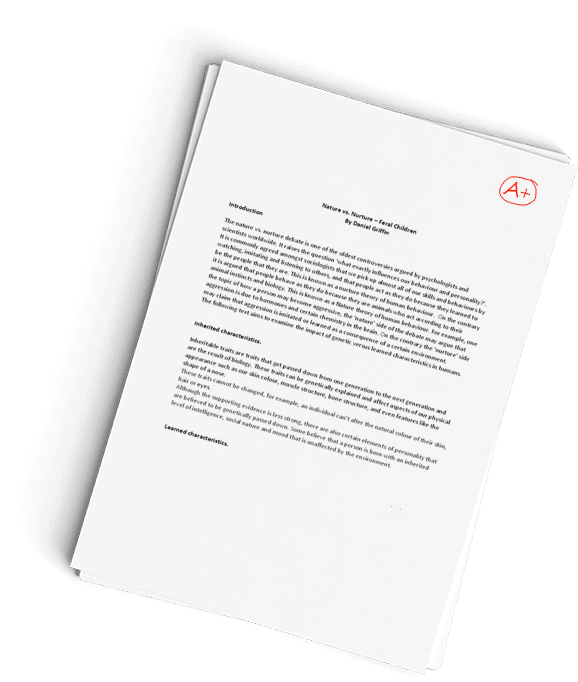Prince Georges Community College Psychology Conformity Analysis Paper
Description
Please provide an aside or constructive feedback to the following two Topics. Do you agree with the analysis presented? Why? Do you have some additional thoughts on the topic? Share them. When providing your feedback present the logic behind it.
Topic 1
Study 1: Conformity (Asch, 1955)
Option 1: Read this article. If you select this article as your feature post, respond to Question Group 1 (listed above).
Asch, S. E. (1955). Opinions and social pressure. Scientific American, 193, 3135. Estate of Sara Love. http://www.wadsworth.com/psychology_d/templates/student_resources/0155060678_rathus/ps/ps18.html
Study 2: Bystander Intervention in Emergencies (Darley & Latane, 1968)
Option 2: Read this article. If you select this article as your feature post, respond to Question Group 1 (listed above).
Please click on the following link. You may have to enter your UMGC log in information to gain access to this UMGC Library resource. The PDF file is on the left-hand side of the page.
Darley, J. M., & Latané, B. (1968). Bystander intervention in emergencies: Diffusion of responsibility. Journal of Personality & Social Psychology, 8(4), 377-383. http://ezproxy.umgc.edu/login?url=http://search.ebscohost.com/login.aspx?direct=true&db=sih&AN=16645191&site=eds-live&scope=site
Study 4: A Pirandellian Prison (Zimbardo et al., 1973)
Option 4: Read this article. If you select this article as your feature post, respond to Question Group 1 (listed above).
Zimbardo, P. G., Haney, C., Banks, C., & Jaffe, D. (1973, April 8). A Pirandellian prison: The mind is a formidable jailer. New York Times Magazine,pp. 38-60. http://www.prisonexp.org/pdf/pirandellian.pdf
Subscribe
DISCUSSION
1. Briefly describe the problem (or research question), the hypothesis, the procedure (participants, methods) and results of the study.
The problem, is that there have been several incidents where individuals in need during an emergent situation, did not receive help even though there were bystanders present. This is known as the bystander effect, and it has been found through this study, and others, that the more bystanders that are present, the less likely an individual is to seek or render assistance for an individual in distress(Darley & Latané, 1968).
In this study, each subject was placed in a room with an intercom system and told that the researcher would not be listening to the discussions among the participants. The subject was under the impression that the participants were discussing college student difficulties on campus. In reality, the participants were pre recorded confederates. During this conversation, one of the participants sounded like he was having a seizure, and even asked for help on the microphone. The subject was then timed to see how long it took them, if at all, to respond and seek out help for the seizing individual. The dependent variable was the time it took for a subject to respond. The independent variable was the number of bystanders the subject believed were also witnessing the seizure event(Darley & Latané, 1968).
The study revealed that 85% did seek help before the seizing person even stopped talking when they believed that they were the only other individual in the conversation. The responsibility fell solely on them. However, when the subject believed that there was another bystander, only 62% sought help by the end of the 6 minute session, and only 31% sought help when the subject believed there were 4 additional bystanders listening(Darley & Latané, 1968).
I agree with the mentioned reasons in this study that suggest when there are more people, the weight of responsibility to act is diffused across several people versus one.
2. Do you see any potential problems with this study, i.e., methodological issues, ethical concerns, etc.?
The potential problem that I saw, was acknowledged by the authors of this study. The fact that this environment kept the subject from seeing the person in need, and seeing the other bystanders makes the study very specific to this type of situation(Darley & Latané, 1968). This was also a scenario that involved a medical emergency without a criminal element, which makes it less threatening to the subject and bystanders to seek help for the person.
3. Do you agree with the authors’ conclusions? Are there other factors we should consider?
I do agree with a lot of the authors conclusions, and found my thoughts to be echoed in their writing. I agree that the response in this situation is not a true reflection of the persons character, apathy, or personality. I think that people assume they would act a certain way in an emergency, or in a certain environment, but when that actually happens, they react completely out of character. I think that this study of a random pool of 68 individuals is evidence to support that not seeking help for someone in an emergency when other bystanders are perceived to be present is not only reflective of poor character(Darley & Latané, 1968). I doubt that all 68 college students have a lack of empathy for others.
4. In your opinion, could this study be repeated today and with the same results? Why or why not?
I think that this study could be repeated with similar results. However, I think that this study and the story of Kitty, have been heard by many. I myself, have heard it in college courses, in my EMT training, and in CPR classes. I would hope that because the bystander effect has been shared in several different educational communities, the results of this type of study, in current day, would yield more help from bystanders then in previous studies.
5. From what you know of social psychology, or other pertinent psychology topics, why might this study have been important?
This study is so important, because the more that people are educated on human behavior, the more they can self analyze and recognize tendencies that we may all have. This study allows us to acknowledge the bystander effect, and remember this in situations where we may be conflicted on acting to help someone in an emergency while others are present.
References
Darley, J. M., & Latané, B. (1968). Bystander intervention in emergencies: Diffusion of responsibility. Journal of Personality & Social Psychology, 8(4), 377-383. http://ezproxy.umgc.edu/login?url=http://search.ebscohost.com/login.aspx?direct=true&db=sih&AN=16645191&site=eds-live&scope=site
Topic 2
Study 3: The Abiline Paradox: The Management of Agreement (Harvey, 1974)
Option 3: Read this article. If you select this article as your feature post, respond to Question Group 2 (listed above).
Whereas, most of us are familiar with the bystander effect and the Stanford Prison Experiment, this study is quite different for those of us who have not had courses in organizational psychology, organizational behavior, or business management. As you will discover, many of the concepts we have learned early on in introductory psychology, social psychology and other courses come into play in this case. See what you think.
Please click on the following link. You may have to enter your UMGC log in information to gain access to this UMGC Library resource. The PDF file is on the left-hand side of the page.
Harvey, J. B. (1974). The Abilene Paradox: The management of agreement. Organizational Dynamics, 3(1), 63 80. doi: 10.1016/0090-2616(74)90005-9 http://ezproxy.umgc.edu/login?url=http://search.ebscohost.com/login.aspx?direct=true&db=bth&AN=5140990&site=eds-live&scope=site
DISCUSSION
1). The Abilene Paradox refers to when Organizations frequently take actions in contradiction to what they really want to do and therefore defeat the very purposes they are trying to achieve (Harvey, 1974). What gets organizations caught in the Abilene Paradox is the inability to manage agreement, not the inability to manage conflict, but there are six sub symptoms that are present in an Abilene group (). One symptom is that members of an organization agree in private, as individuals, to the steps that would be needed to cope with whatever situation or problem they face (). For example, with the Abilene group, a situation in which something remains the same or coming into more of the same is a solution that would satisfy an individual and their collective desires (Harvey, 1974). Another symptom is that members of an organization fail to accurately communicate their desires and/or beliefs to one another (Harvey, 1974). They would, in fact, do the opposite and in turn, lead each member into misperceiving the collective reality (Harvey, 1974).
2). A case study described in this article is The Boardroom. This case study is about the Ozyx Corporations president hiring a consultant to help discover the reasons behind some of the companys issues. During this investigation, the consultant shows interest in a research project which the company has invested a proportion of its R&D budget (Harvey, 1974). When the president, vice-president for the research, and the research manager were asked what they thought about this project, they all said it looked good on paper but would eventually fail because of the lack of availability of the technology needed to make it work (Harvey, 1974). Each member shared that they had not discussed the thoughts with the other members of the organization. All of them wanted to remain in silence for fear that they would make the company look bad and did not disappoint the other. For example, the president didnt want to say anything because he thought it would cause the vice-presidents ulcer to kick up or perhaps even cause him to quit… (Harvey, 1974). The vice-president didnt want to say anything because he thought the president was so committed to the plan and he thought he would be fired if he said anything; the research manager wanted to stay silent because he believed the president and vice-present were extremely committed to the projects success (Harvey, 1974).
3). The five factors discussed are: Action Anxiety, Negative Fantasies, Real Risk, Separation Anxiety, and the Psychological Reversal of Risk and Certainty. Action Anxiety provides the first landmark for locating roadways that bypass Abilene (Harvey, 1974). This concept says that the reason organization members take actions in contradiction to their understanding of the organization’s problems lies in the intense anxiety that is created as they think about acting in accordance with what they believe needs to be done (Harvey, 1974). Because of this, they decide to go through the economic and professional degradation of following an unworkable research project instead of acting in a manner concurring with their beliefs (Harvey, 1974). Action Anxiety is supported by the negative fantasies that members of an organization may have about would happen as a result of their acting in accordance with their understanding of what is sensible (Harvey, 1974).
4). One term that is described as a risk factor of the model is collusion. An implication of the Paradox is that the human problems of organization are reciprocal in nature (Harvey, 1974). Each person is self-defeating (Harvey, 1974). As Robert Tannenbaum describes, you can’t have an autocratic boss unless subordinates are willing to collude with his autocracy, and you can’t have obsequious subordinates unless the boss is willing to collude with their obsequiousness (Harvey, 1974). This makes me think of the definition of social psychology, how the social influence and interaction influences a person or groups behavior. Without the following and colluding of subordinates, you cannot have a powerful boss, and without a powerful boss, you cannot have these subordinates unless the boss is willing to collude with their obedience.
5). Harvey suggests diagnosing and then confronting the Paradox. The key to diagnosing the Paradox is to first answer the question: Is the organization involved in a conflict-management or an agreement-management situation? (Harvey, 1974).
6). Harvey offers recommendations for coping with the paradox. If a preliminary diagnosis leads an individual to believe he or the organization is on their way to Abilene, confrontation in a group setting may be effective (Harvey, 1974).
Harvey, J. B. (1974). The Abilene Paradox: The management of agreement. Organizational Dynamics, 3(1), 63 80. doi: 10.1016/0090-2616(74)90005-9 http://ezproxy.umgc.edu/login?url=http://search.ebscohost.com/login.aspx?direct=true&db=bth&AN=5140990&site=eds-live&scope=site
Have a similar assignment? "Place an order for your assignment and have exceptional work written by our team of experts, guaranteeing you A results."








